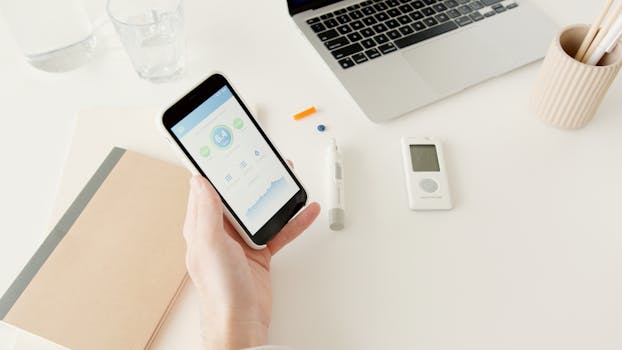Anúncios
Can a smartphone app or a small sensor really change how patients and providers work together? This guide starts with that question to show why digital health matters now.
The U.S. health care landscape is shifting from wellness gadgets to clinically useful systems. IQVIA counted 337,000 digital health apps and more than 360 software-based digital therapies as of December 2024. Regulators and the FDA have cleared many AI/ML-enabled devices and approvals for sensor-based endpoints are emerging.
This section outlines practical, evidence-informed ways to evaluate options. You will find real examples, adoption tips, and signals to help decide what fits your clinic or personal needs. We avoid medical guarantees and stress clinician oversight.
Expect coverage of assessment, diagnosis, treatment support, and monitoring—with attention to privacy, governance, and equity so access does not widen disparities. Use this guide to pilot responsibly and consult licensed professionals for care decisions.
Introduction: Why healthtech tools matter right now
Today’s digital health innovations are shifting from consumer apps to clinic-ready systems. Evidence and clearer regulatory paths are helping clinicians and health systems evaluate options rather than guess which products work.
Anúncios
IQVIA reports about 337,000 digital health apps, and by June 2024 the U.S. FDA had cleared 801 AI/ML-enabled devices, including roughly 75 mobile and point-of-care products. This growth means more category-specific, evidence-backed diagnostics and digital therapeutics that can improve access and support routine care at home or in clinics.
How this guide helps: it prioritizes practical choices that align with workflow, privacy norms, and equity. You will find actionable selection criteria, rollout tips, and questions for providers and IT teams. This is educational information only and not medical advice. Use these insights to start informed conversations, plan pilots, and track outcomes while protecting patient data and digital literacy.
AI and machine learning diagnostics leading the way
AI-driven diagnostics are reshaping clinical workflows by turning raw signals into actionable insights. Across imaging, cardiology screening, dermatology triage, and point-of-care systems, artificial intelligence and machine learning power decision-support that speeds assessment while keeping clinicians central to care.
Anúncios
FDA-cleared devices and real-world examples
By June 2024 the FDA had authorized 801 AI/ML-enabled devices, including roughly 75 mobile and point-of-care products. IQVIA lists 100+ digital diagnostics for conditions such as sleep apnea, atrial fibrillation, skin cancer, epilepsy, and sepsis.
Examples include AI-assisted atrial fibrillation detection from wearable signals and algorithmic triage for suspicious skin lesions. These systems flag findings for follow-up; confirmatory testing and clinician judgment remain essential.
Practical implementation and governance
Data governance matters: de-identification, access controls, model monitoring, and clear documentation of intended use and performance limits reduce risk.
Fairness checks should compare performance across age, race, and care settings to detect bias. Post-market surveillance and feedback loops keep models current and safe.
Workflow fit and rollout tips
- Integrate models with clear escalation paths to avoid alert fatigue.
- Validate features in local settings and involve IRB or compliance for trials and measures.
- Phase rollouts with clinician training and patient-friendly explanations about benefits, limits, and data protection.
Digital therapeutics (DTx) you should watch
A new class of regulated software is helping patients follow evidence-based treatment plans outside the clinic.
What DTx are and where they’re used
Digital therapeutics are software that delivers evidence-based interventions for defined conditions. They run in clinics or at home and operate under provider guidance.
They support care—not replace clinical judgment—and often pair with in-person visits and monitoring.
Approved categories and examples
Common indications include behavioral and mental health programs, VR for certain pain, neuromotor and post-stroke rehab, visual and respiratory supports, and exposure therapies for PTSD and phobias.
IQVIA lists 360+ commercially available DTx worldwide: about 140 for at-home use and 220+ used in clinics. Germany reimburses 56, the U.S. has 46 approved, and the UK reports 20.
Evidence, reimbursement, and practical rollout
U.S. reimbursement is emerging; payers usually follow robust research and real-world outcomes. Monitor adherence, patient-reported outcomes, and safety signals to justify coverage.
- Confirm eligibility and contraindications before prescribing.
- Set structured onboarding and regular follow-up to track engagement.
- Integrate DTx with the health system EHR to log use and outcomes.
Privacy and consent matter: explain what data are collected, where they are stored, and who may access them.
Start with a pilot cohort, refine workflows, and expand based on measured outcomes. Encourage patients to discuss DTx with their providers and use them as a complement to clinician-led care.
Wearables and sensor-based digital biomarkers
Wearable sensors are turning everyday movements and heartbeats into measurable signals clinicians and researchers can use.
How sensors work: Accelerometers, photoplethysmography, and motion sensors translate movement, heart rhythm, and sleep patterns into objective measures. These signals can inform conversations about symptoms and support research studies.
From activity to disease-specific signals
Some wearable-derived findings can flag possible sleep apnea or irregular heart rhythms like atrial fibrillation. Consumer devices such as Fitbit and Apple Watch surface activity and heart rate variability as wellness information, not medical diagnoses.
Regulatory progress: digital endpoints in trials
Regulators in the U.S. and Europe now recognize wearable-based digital endpoints in clinical trials. That acceptance helps standardize data and reduce participant burden in decentralized research.
Practical tips for patients and clinicians
- Use apps to track trends, set step and sleep goals, and work to improve health habits safely.
- Share summarized device data with your clinician for better history-taking; always confirm privacy and consent.
- Watch for tech limits: battery life, sensor accuracy, and software updates affect data quality.
Remember: If a device flags worrying symptoms, contact a clinician rather than relying on the device alone. Wearables add useful information but do not replace clinical judgment.
Remote patient monitoring and hospital-at-home platforms
Combining wearables, symptom check-ins, and clinician workflows creates new pathways for short-term acute care at home. These models pair connected devices with scheduled observation to extend clinician reach and support patient care between visits.
Continuous monitoring: RPM platforms collect streaming vitals and regular symptom reports so teams can spot trends sooner. IQVIA highlights integrated clinical platforms that merge wearable signals and check-ins to detect recurrence and predict changes.
Clinical workflow: alert thresholds and escalation paths
Set clear alert thresholds and route notifications to the right team. Define steps: automated triage, a virtual clinician check, then in-person evaluation if needed.
Safety protocols include consent, device training, connectivity troubleshooting, and routine device status checks. Loaner devices, language support, and caregiver instruction help improve access and equity.
“RPM and hospital-at-home are supportive systems that may help teams detect deterioration earlier; they do not replace emergency care.”
- Document inclusion criteria and consent for each patient.
- Monitor adherence and log device status to minimize gaps.
- Track readmission rates, time-to-intervention, patient experience, and staff workload.
Implementation tip: Start with a pilot, iterate with frontline providers and home health partners, and align protocols across health systems to keep transitions safe and clear.
Electronic health record add-ons and medical dictation tools
Medical dictation has evolved: modern voice models produce structured drafts that clinicians can quickly review. These add-ons sit alongside EHR systems to capture encounters, reduce typing, and keep the clinician in charge.
Reducing administrative burden with voice and ambient AI
Ambient AI scribing listens to visits, extracts key findings, and drafts problem-oriented notes for clinician sign-off. That workflow gives providers more face time with the patient and less time entering data.
Benefits include clearer, consistent notes that support downstream coding, referrals, and care coordination across the health system.
Data quality and privacy considerations within EHRs
Safeguards are essential: on-device processing when possible, encryption in transit and at rest, role-based access, and immutable audit logs. Consent and PHI controls should be explicit in vendor contracts.
Model limits require final human review; AI must assist, not replace, clinical judgment. Train staff on prompt phrasing, correction workflows, and when to use manual entry.
- Integrate templates to improve quality and consistency.
- Vet vendors for HIPAA alignment, uptime, and transparent updates.
- Measure documentation time, note quality, and burnout to guide optimization and research projects.
Collaboration and communication tools across health systems
Connecting directories, chat, and schedules gives clinicians a single place to coordinate care across systems. Centralized messaging reduces the time spent finding on-call staff and improves handoffs without promising specific outcomes.
Secure messaging and on-call coordination for faster decisions
Core features include encrypted chat, role-based on-call schedules, rapid broadcast alerts, and integrated directories so providers find the right clinician fast.
Practical governance covers acceptable use, auditing, escalation paths, and incident response aligned with HIPAA and local policy.
- Standardized handoff templates and read receipts support quality care and reduce misunderstandings.
- Integrations with EHRs and paging systems cut app switching and streamline workflows.
- Start pilots in high-acuity units, collect feedback, and tune alert thresholds to avoid fatigue.
“Centralized physician communication tools accelerated during the pandemic years, improving workflow efficiency.”
Track impact with response times, time-to-consult, and handoff defects over the first months and years. Include nursing, hospitalists, and IT on rollout teams and train on downtime procedures for resilience.
Augmented/virtual reality, robotics, and 3D printing in care delivery
AR, VR, robotics, and 3D printing are supportive technologies that help clinicians, logistics teams, and biomedical staff work more efficiently. These innovations assist training, automate routine tasks, and create custom parts when supply chains strain.
AR-assisted procedures and VR training for clinicians
AR overlays can show anatomical orientation during procedures, reducing cognitive load and improving spatial awareness for providers. VR simulations let clinicians rehearse uncommon cases in realistic, low-risk settings.
Benefits include faster skill reinforcement and measurable training completion rates. Content must be updated and validated by clinical teams and research partners.
Service robots and logistics automation in hospitals
Service robots can move linen, meals, and supplies autonomously, freeing staff for patient-facing care and lowering repetitive strain. Several hospitals deployed robots during high-demand periods and reported smoother staff flow.
Expect efficiency gains but also costs for maintenance, navigation checks, and infection control policies.
3D printing for rapid supply support and custom components
3D printing enables fast fabrication of adapters, fixtures, and training models when regular supplies lag. During the pandemic, printed PPE and adapters filled urgent gaps and remain useful for custom parts today.
- Weigh procurement steps: identify clinical champions, run safety assessments, and check facility integration (doors, elevators, network).
- Measure impact across years: setup time saved, error reduction in logistics, and training completion rates.
- Partner with biomedical engineering and research to validate designs and ensure quality control.
“Start with a pilot, measure outcomes, and expand only after safety, cost, and staff readiness are proven.”
Cloud, data platforms, and gen AI for operational efficiency
Modern cloud services can turn scattered clinical records into actionable workflows that save staff hours each week.
Why it matters: unified data stores, secure APIs, and analytics let organizations surface the right information at the right time. That reduces manual inbox work and speeds routing for prior authorizations and referrals.
Streamlining workflows: Prior authorizations, triage, and summaries
Generative AI assistants can draft visit summaries, format authorization packages, and suggest routing paths for requests.
Always require human verification: clinicians and staff must review outputs before they enter the record or drive decisions.
- Map common patterns: unified data stores, secure APIs, and analytics to track patient flow.
- Integrate with ticketing, contact centers, and EHR inboxes to cut clicks and reduce cognitive load.
- Set measurable goals: turnaround time, documentation quality, and staff satisfaction.
Responsible AI: Guardrails, evaluation, and human oversight
Governance steps: perform risk assessments, bias evaluations, and ongoing model performance monitoring.
Protect PHI with strong identity management, encryption, data residency controls, and minimal necessary use. Vet vendors on training data, update cadence, red-teaming, and outage fallbacks.
- Document incident management and fallback procedures.
- Require provenance checks and final human sign-off for outputs that touch clinical workflows.
- Train providers and operations staff; keep feedback loops for continuous improvement.
“Responsible deployment improves consistency and can lower administrative costs without sacrificing safety.”
healthtech tools adoption: evidence, integration, and reimbursement
Getting from a promising pilot to routine use depends on evidence, workflow fit, and payment pathways. Successful adoption balances clinical utility, user experience, and measurable returns.

What drives uptake: Clinical utility, usability, and cost savings
Drivers include clear benefits in outcomes and time savings for clinicians and patients. Usability must suit frontline staff and diverse patients.
Products backed by trials and robust research reach clinicians and health systems faster. Consider published frameworks like this evaluation checklist when assessing evidence.
Pilot-to-scale roadmap: Interoperability, training, and ROI tracking
- Define success metrics: quality, patient experience, operational savings, and safety checkpoints.
- Ensure interoperability with EHRs and device ecosystems to cut manual work and errors.
- Set training and super-user programs to collect feedback and sustain adoption.
- Plan reimbursement paths, document coding, and align trials to payer evidence needs.
- Include equity checks so digital health interventions improve health for all populations.
“Adoption is continuous: refine based on evidence and governance, and consult qualified professionals for clinical decisions.”
Conclusion
, Maturing technologies are creating clearer paths to safer, measurable improvements in patient care.
Digital health tools and select apps can support prevention, assessment, and follow-up without replacing clinician judgment. Small pilots help test workflows, equity, and outcomes before broad rollout.
These systems can surface early signals for disease and chronic diseases, and digital therapeutics and health apps are growing in areas like mental health, cardiometabolic care, and rehab. Evidence, reimbursement, and levels of maturity will evolve over years.
Build knowledge from trusted sources, check product documentation, and prioritize transparency about data handling. Consult licensed professionals for diagnosis and treatment and use digital aids to improve health safely.



